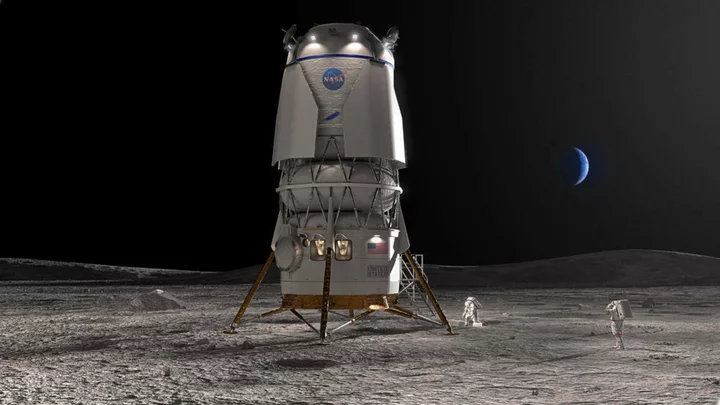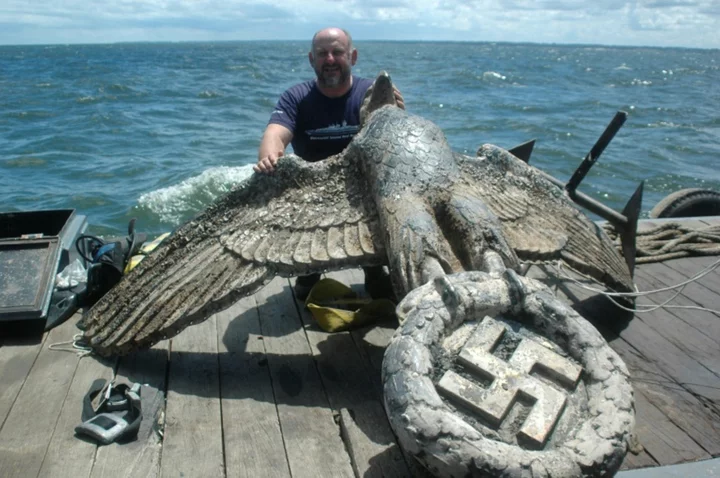One of the richest men on Earth will finally have his chance to build a spaceship for landing people on the moon.
NASA announced it selected billionaire Jeff Bezos' space company Blue Origin to make its lunar lander for Artemis V, a mission slated to put astronauts near the moon's south pole in 2029.
And with the Friday announcement came the unveiling of the moon lander's official name, sure to thrill orange-flavored wheat beer enthusiasts: Blue Moon.
SEE ALSO: Get ready: SpaceX Starship will try to fly again soon"We always hoped Blue Moon (the beer) would land in space one day, but we’re excited to see it will land on the moon in such an iconic mission," the brewery said in a statement to Mashable. "While we won’t be involved in this lunar landing, we’ll be excited to welcome the team back home on Earth at the bar with a Blue Moon Belgian White on draft.”
Their excitement wasn't unexpected: Soon after Blue Origin's proposed lander name surfaced in 2019, the brewers designed a limited edition keg in the form of a lunar lander with the Blue Moon logo prominently displayed.
The product overlap didn't escape Elon Musk's notice, founder of SpaceX and Bezos' chief competitor:
"But putting the word 'Blue' on a ball is questionable branding," he tweeted then.
The Blue Origin contract will provide NASA with a second ride to the moon. The U.S. space agency intends to use SpaceX Starships to land astronauts on the lunar surface during Artemis III and IV, two upcoming missions which could come as early as 2025 and 2028, respectively, with an extended contract worth $4 billion. As part of the deal, the company will need to demonstrate an uncrewed test flight to the moon beforehand.
During Artemis III, Starship will transfer astronauts from NASA's Orion spacecraft to the lunar south pole and back. But in the fourth mission, Starship is expected to dock at a moon-orbiting space station, the yet-to-be-built Gateway, and ferry astronauts back and forth to the moon.
That is also the expectation for Blue Moon, which will perform several test flights without passengers using the company's rocket, New Glenn, said Blue Origin vice president John Couluris, a launch vehicle that hasn't flown in space yet.
This outcome for Blue Origin, a $3.4 billion contract, follows a bitter rivalry between the two big private space companies. Bezos' company lost its bid for the first lander contract to SpaceX, and NASA opted to extend its deal with the competitor for Artemis IV. Wanting to overturn the decision, Blue Origin unsuccessfully sued the space agency in a U.S. federal claims court last year.
Want more science and tech news delivered straight to your inbox? Sign up for Mashable's Light Speed newsletter today.
Under the Artemis V contract, Blue Origin will work with several industry partners: Lockheed Martin, Draper, Boeing, Astrobotic, and Honeybee Robotics.
During a news conference in Washington on Friday, NASA administrator Bill Nelson said using private vendors will help the agency buy down the technical risks and costs for the Artemis program, which seeks to use the moon as a springboard for eventual missions to Mars.
"I've said it before: We want more competition. We want two landers, and that's better, and it means that you have reliability. You have backups," Nelson said. "These are public-private partnerships. It's the new way that we go to the moon."
People within the ispace mission control center react to losing communication with the Hakuto-R lander on April 25, 2023. Credit: ispace / YouTube screenshotOver the past four years, the private sector and other spacefaring agencies have tried and failed to land on the moon with crewless spacecraft. An Israeli nonprofit and company collaborated in 2019 on the Beresheet mission, which crashed on the lunar surface after an orientation component failed. Just last month, a Japanese startup, ispace, crashed as it tried to land. Company officials said a preliminary investigation determined the lander ran out of fuel.
Couluris told Mashable during the news conference that Blue Origin is up to the task, in part because of its esteemed partners, such as Lockheed and Boeing, which bring loads of experience to the team. NASA is also providing insights.
"It's kind of like a perfect blending of what we're trying to do, of lessons learned, so we don't repeat those 'lessons' again," he said.









